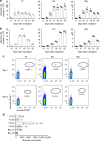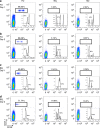Mature IgDlow/- B cells maintain tolerance by promoting regulatory T cell homeostasis
- PMID: 30643147
- PMCID: PMC6331566
- DOI: 10.1038/s41467-018-08122-9
Mature IgDlow/- B cells maintain tolerance by promoting regulatory T cell homeostasis
Abstract
A number of different B cell subsets have been shown to exhibit regulatory activity using a variety of mechanisms to attenuate inflammatory diseases. Here we show, using anti-CD20-mediated partial B cell depletion in mice, that a population of mature B cells distinguishable by IgDlow/- expression maintains tolerance by, at least in part, promoting CD4+Foxp3+ regulatory T cell homeostatic expansion via glucocorticoid-induced tumor necrosis factor receptor ligand, or GITRL. Cell surface phenotyping, transcriptome analysis and developmental study data show that B cells expressing IgD at a low level (BDL) are a novel population of mature B cells that emerge in the spleen from the transitional-2 stage paralleling the differentiation of follicular B cells. The cell surface phenotype and regulatory function of BDL are highly suggestive that they are a new B cell subset. Human splenic and peripheral blood IgDlow/- B cells also exhibit BDL regulatory activity, rendering them of therapeutic interest.
Conflict of interest statement
The authors declare no competing interests.
Figures










References
Publication types
MeSH terms
Substances
Grants and funding
LinkOut - more resources
Full Text Sources
Other Literature Sources
Molecular Biology Databases
Research Materials

